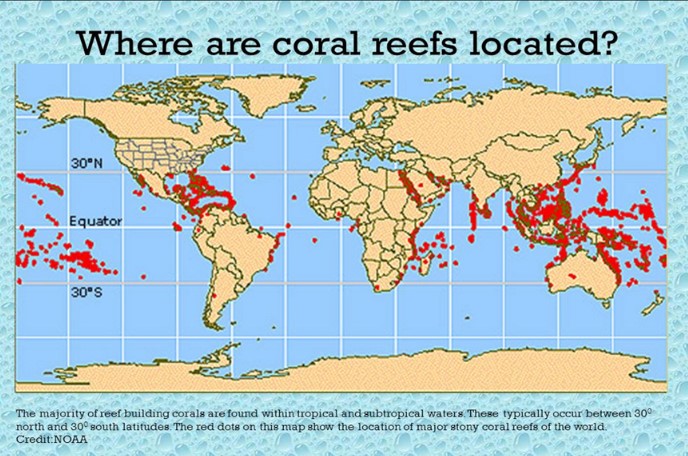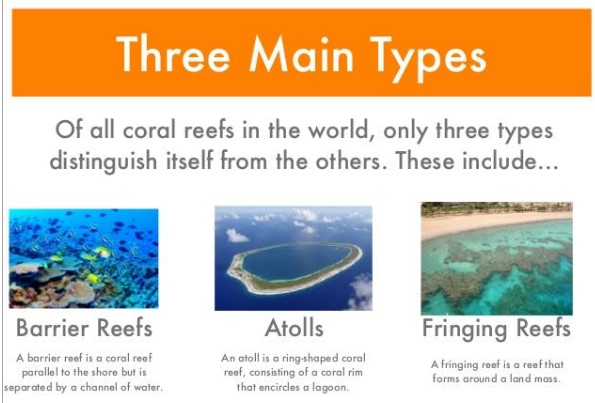Threats to coral ecosystem
2021 DEC 21
Mains >
Environment & Ecology > Biodiversity > Coral reefs

WHY IN NEWS?
- Sixth Status of Corals of the World Report, 2020 of Global Coral Reef Monitoring Network reveals that coral cover declines sharply with rapid increases in sea surface temperatures, indicating their vulnerability to temperature spikes, and found that this phenomenon is likely to increase as the planet continues to warm.
INTRODUCTION:
|
Hard corals v/s soft corals
The coral species that build reefs are known as Hard Corals because they extract calcium carbonate from seawater to create a hard, durable exoskeleton that protects their soft, sac-like bodies.
The other species of corals that are not involved in reef building are known as Soft Corals.
|
- Coral reefs are large underwater structures composed of the skeletons of colonial marine invertebrates called coral.
- Each individual coral is referred to as a polyp.
- Coral polyps live on the calcium carbonate exoskeletons of their ancestors, adding their own exoskeleton to the existing coral structure.
- The Corals have a symbiotic, or mutually beneficial, relationship with the zooxanthellae.
- The zooxanthellae provide the coral with their lively colors.
- Most coral polyp bodies are clear and colorless without zooxanthellae
- About 25% of all known marine species rely on coral reefs for food, shelter and breeding.
- These are sometimes referred to as ‘the rainforests of the sea’ for their biodiversity.
CONDITIONS FOR THE GROWTH OF CORAL POLYPS:
- Extensive submarine platforms for the formation of colonies by the coral polyps (not more than 90m below sea level.)
- High mean annual temperature ranging 20-210C. Hence, they are mainly seen in tropical seas and oceans.
- Sufficient amount of sunlight and oxygen. Thus, they do not live in deeper waters i.e. not more than 60-77m below sea level.
- Clean sediment-free water because muddy water or turbid water clogs the mouths of coral polyps resulting into their death.
- Oceanic salinity ranging between 27-30 ppt. High oceanic salinity or fresh water is injurious for the growth of corals. Hence, they avoid river mouths and waters containing little amount of calcium carbonates.
- Ocean currents and waves, as they bring food supply for the polyps.

STATISTICS:
- As per Global Coral Reef Monitoring Network:
- Between 2009 and 2018, the continuous rise in sea temperature cost the world 14 per cent of its coral reefs.
- Since 2010, the amount of algae on the world's coral reefs has increased by about 20 per cent. Algal bloom on coral ridges are a sign of stress on the structures.
DISTRIBUTION OF CORALS:
- World:
- Coral are found in more than 100 countries around the world.
- Most reefs are located between the Tropics of Cancer and Capricorn, in the Pacific Ocean, the Indian Ocean, the Caribbean Sea, the Red Sea, and the Persian Gulf.
- Corals are also found farther from the equator in places where warm currents flow out of the tropics, such as in Florida and southern Japan.
- In India:
- Gulf of Kutch, Gulf of Mannar, Andaman and Nicobar, Lakshadweep Islands, Netrani Island in Karnataka, Angria Bank in Maharashtra etc.
SIGNIFICANCE:
- Ecological importance:
- Dynamic underwater coral cities support up to 800 different species of hard coral and are home to more than 25 per cent of all marine life
- Coral reefs harbour the highest biodiversity of any of the world’s ecosystems, making them one of the most biologically complex and valuable on the planet.
- Example: The Coral Triangle - a coral-rich marine region in Southeast Asia that encompasses the waters between Indonesia, Malaysia, the Philippines and Papua New Guinea - is the most biologically diverse marine ecosystem on Earth.
- Example: Great Barrier Reef (Australia) contains over 400 coral species, 1,500 fish species, 4,000 mollusc species and six of the world's seven sea turtle species
- Carbon sequestration:
- Coral reefs remove carbon dioxide from the atmosphere and are thus responsible for mitigation of global warming.
- Coastal protection
- Absorb wave energy and contribute to reduction of coastal erosion
- Reduce damage in the event of storms, cyclones and tsunami.
- They help protect areas such as mangrove forests and seagrass beds that act as nurseries for marine animals, as well as human coastal populations.
- Medical field:
- Extracts from animals and plants living on reefs have been used to develop treatments for asthma, arthritis, cancer and heart disease.
- Economic benefits:
- Estimated USD30 billion economic benefits through fisheries, tourism etc.
THREATS TO CORAL REEFS:
- Local threats:
- Physical damage
- It includes destruction from coastal development, dredging, quarrying, destructive fishing practices and gear, boat anchors and groundings, and recreational misuse (touching or removing corals).
- Pollution that originates on land but finds its way into coastal waters. This includes:
- Sedimentation from coastal development, urban stormwater runoff, forestry, and agriculture.
- Excessive nutrients (nitrogen and phosphorous) from agricultural and residential fertilizer use, sewage discharges and animal waste, which can lead to the growth of algae that blocks sunlight and consumes oxygen corals need for respiration.
- Toxic pollutants from industrial discharges, sunscreens, urban and agricultural runoff, mining activities, and runoff from landfills.
- Trash and micro-plastics from improper disposal and stormwater runoff.
- Overfishing
- It can alter the food-web structure and cause cascading effects, such as reducing the numbers of grazing fish that keep corals clean of algal overgrowth.
- Blast fishing (i.e., using explosives to kill fish) can cause physical damage to corals as well.
- Coral harvesting
- Coral harvesting for the aquarium trade, jewelry, and curios can lead to over-harvesting of specific species, destruction of reef habitat, and reduced biodiversity.
- Global threats:
- Ocean Acidification:
- The increasing acidification of the ocean caused when oceans absorb immense amounts of carbon dioxide released into the atmosphere inhibits coral's ability to produce the calcium carbonate exoskeletons they rely on for shelter.
- With increased CO2 in the water, coral may form weaker skeletons, making them more vulnerable to disease and destruction by storms.
- Coral Bleaching:
- When corals are stressed due to warmer ocean waters, the corals eject the symbiotic algae that live inside them when stressed. When corals lose their algae, they lose their built-in food source.
- Sea level rise:
- As the planet gets warmer, glaciers melt, causing sea level to rise.
- Thus, corals are predicted to end up deeper underwater, receive less sunlight and grow more slowly.
- Stronger Storms:
- Stronger, more frequent storms, hurricanes, cyclones can break coral branches and overturn coral colonies.
- Weaker ocean currents:
- Changes in climate, which affects the flow of ocean currents and thereby impacts the nutrient availability for corals.
INITIATIVES TO PROTECT CORAL REEFS:
- International level:
- UN Sustainable Development Goals
- Goal 14 - Life below water
- Global Coral Reef Partnership
- Initiated by UNEP and Regional Seas Conventions and Action Plans to support countries deliver internationally agreed coral reef commitments through ecosystem-based management of coral reefs.
- International Coral Reef Initiative (ICRI)
- A partnership of Nations and organizations which strives to preserve coral reefs and related ecosystems.
- Global Coral Reef Monitoring Network
- It works through a global network to strengthen the provision of best available scientific information on and communication of the status and trends of coral reef ecosystems, for their conservation and management.
- Global Coral Reef Alliance
- A coalition of volunteer scientists, divers, environmentalists and other individuals and organizations, committed to coral reef preservation.
- National level:
- Legislative:
- Wild Life Protection Act, 1972:
- Coral reef is included in Schedule I of the Wild Life Protection Act, 1972 which affords it the highest degree of protection.
- Protected Areas, viz. National Parks, Sanctuaries and Marine Biosphere Reserve have been created all over the country under the provisions of the Wild Life (Protection) Act, 1972 to conserve marine life including coral reef.
- Environment Protection Act 1986
- Water (Prevention and Control of Pollution) Act 1974
- Regulatory:
- Coastal Regulation Zone (CRZ) notifications:
- Issued under the Environment Protection Act, 1986
- To protect and conserve the environment and ecosystem on the coastline of the country.
- The mangroves and coral reefs areas are categorized as ecological sensitive areas (CRZ-I) where no new constructions are permitted with a few exceptions.
- Island Protection Zone (IPZ)
- To protect the unique ecosystem found in the islands
- Research:
- Zoological Survey of India has been undertaking studies on the serious threat to coral colonies in India.
SUGGESTIONS
- Check marine pollution:
- Strong and coordinated action to address land-based pollution as 80% marine pollution originates from land addressing three priority source categories, namely marine litter, nutrient management, and wastewater
- Sustainable use of marine resources
- Encouraging sustainable use of the coral ecosystem by controlling overfishing, reef mining etc. and banning harmful practices like bottom trawling, cyanide fishing, blast fishing etc.
- Ecosystem approach:
- Ecosystem approach to conserving the coastal ecosystem involving coral reefs, mangroves and sea grass beds.
- Recognizing and classifying protected areas:
- Promoting effective marine protected areas and regulating shipping, tourist activities, coastal construction etc.
- Awareness generation:
- Creating awareness among local people about the importance of coral reefs and involving them in the conservation of coral ecosystems.
- Use of technology:
- Promoting the growth of corals through artificial means like Biorock/ Mineral Accretion Technology etc.
- Research and development:
- Investing in research and development and documentation of genetic characteristics of reef communities to enable the management of reef ecosystems through modern techniques and international collaboration.
PRACTICE QUESTION:
Q. Discuss the threats face by coral reefs. What measures have been taken to ensure their protection

